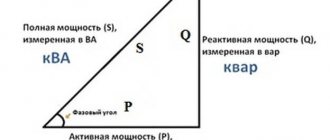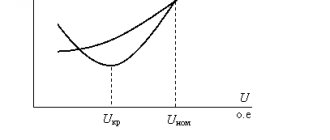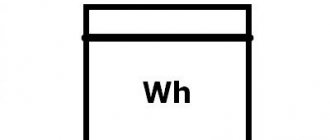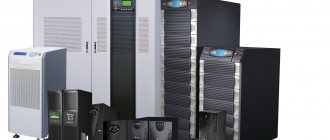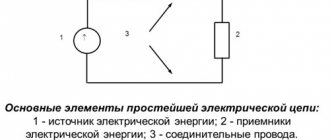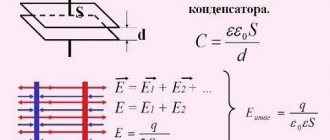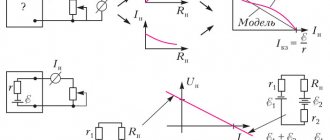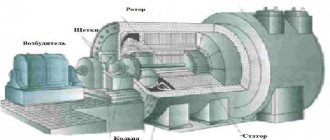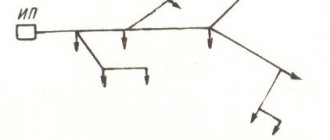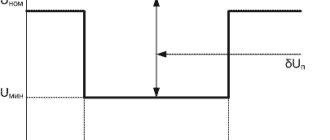Active and reactive electrical energy meters
The most common type of electrical measuring instruments are active and reactive energy meters.
There are single-phase and three-phase meters . Single-phase meters are used to account for electricity from consumers powered by single-phase current. To account for three-phase electricity, three-phase meters are used. Three-phase meters can be classified as follows.
According to the type of measured energy - active and reactive energy meters .
Depending on the power supply circuit for which they are intended - three-wire meters operating in a network without a neutral wire. And four-wire ones , operating in a network with a neutral wire.
According to the method of switching on, meters can be divided into 3 groups:
— Direct connection meters (direct connection) are connected to the network without instrument transformers. Such meters are produced for 0.4/0.23 kV networks for currents up to 100 A.
— Semi-indirectly switched meters, with their current windings, are switched on through current transformers. The voltage windings are connected directly to the network. Scope of application: networks up to 1 kV.
— Indirectly connected meters are connected to the network through current transformers and voltage transformers. Scope of application: networks above 0.4 kV. Available in two types.
Transformer meters - designed to be switched on through measuring transformers.
Transformer universal meters - designed to be switched on through measuring transformers with any transformation ratio. For universal meters, the conversion factor is determined by the transformation ratios of the installed measuring transformers.
Depending on the purpose, the counter is assigned a symbol. In the designations of counters, letters and numbers mean: C - counter; O - single-phase; A - active energy; R - reactive energy; U - universal; 3 or 4 for a three or four wire network.
Designation example: SA4U - three-phase transformer universal four-wire active energy meter. M is placed on the meter plate , this means that the meter is designed to operate at negative temperatures (-150 - +250 C). Active and reactive energy meters equipped with additional devices are classified as special-purpose meters.
Two-tariff meters are used to account for electricity, the tariff for which varies depending on the time of day.
Pre-payment meters are used to meter electricity for household consumers living in remote and hard-to-reach settlements.
Meters with a maximum load indicator are used for settlements with consumers at a two-part tariff (for consumed electricity and maximum load).
Telemetering meters - used for electricity metering and remote transmission of readings. Special-purpose meters also include standard meters intended for testing general-purpose meters. The technical characteristics of the meter are determined by the following main parameters.
Rated voltage and rated current - for three-phase meters they are indicated as the product of the number of phases by the rated values of current and voltage, for four-wire meters the linear and phase voltages are indicated, for example: 3 5 A; Z 380/220V.
For transformer meters, instead of rated current and. voltage, the nominal transformation ratios of the measuring transformers for which the meter is intended to work are indicated, for example: 3 150/5 A, 3 6000/100 V. On meters called overload , the value of the maximum current is indicated immediately after the rated one, for example 5-20A. The rated voltage of meters for direct and semi-indirect connection must correspond to the rated voltage of the network, and for counters of indirect connection - to the secondary rated voltage of the TN.
Likewise, the current rating must match the secondary current rating of the current transformer (5 or 1 A). Meters allow long-term overcurrent without violating the correctness of metering: transformer and transformer universal - 120%; direct connection meters - 200% or more (depending on type).
The meter's accuracy class is its greatest permissible relative error, expressed as a percentage (the ratio of the absolute error to the actual meter readings; absolute error is the difference between the actual meter readings and the readings of the reference sample). In accordance with GOST 6570-75*, active energy meters must be manufactured in accuracy classes; 0.5; 1.0; 2.0; 2.5; reactive energy meters of accuracy classes 1.5; 2.0; 3.0.
Transformer and transformer universal meters for active and reactive energy metering must be of accuracy class 2.0 or more accurate.
The accuracy class is established for operating conditions called normal.
They will be referred to:
— direct phase rotation;
— uniformity and symmetry of loads across phases;
— sinusoidality of current and voltage (linear distortion coefficient no more than 5%);
— nominal frequency (50 Hz±0.5%);
— rated voltage (±1%);
— rated load;
— cos = l (for active energy meters) and sin = l (for reactive energy meters);
— ambient air temperature 20°±3° C (for indoor meters);
— absence of external magnetic fields (induction no more than 0.5 mT);
— vertical position of the counter.
A watt-hour meter (active energy meter) is an instrument designed to measure active energy by integrating active power over time.
A var-hour meter (reactive energy meter) is an integrating device that measures reactive energy in var-hours or its multiples.
The meters can be designed for two-wire single-phase networks, three-wire three-phase networks without a neutral wire and four-wire three-phase networks with a neutral wire.
Active energy metering should provide determination of the amount of electricity:
— generated by power plant generators;
— consumed for own and economic needs of the power plant and substations;
- supplied to electric consumers via lines extending from power plant buses directly to electric consumers;
— transferred to other energy systems;
— released to electrical consumers from the electrical network.
In addition, active energy accounting should provide the ability to:
— accounting for electricity supplied to electrical networks at different voltage levels of the power system;
— drawing up an energy balance for self-supporting units of the energy system;
— control over compliance by electricity consumers with the prescribed consumption modes and electricity balance.
Accounting for reactive electricity should provide the ability to determine the amount of reactive electricity received by the consumer from the power supply organization or transferred to it only if these data are used to make calculations or monitor compliance with the specified operating mode of compensating devices.
Reactive electricity meters must be installed:
1) on the same circuit elements on which active electricity meters are installed for consumers paying for electricity taking into account the reactive power allowed for use;
2) at connections of consumer reactive power sources, if they are used to pay for electricity supplied to the power system network, or control the specified operating mode.
If the enterprise, with the consent of the power system, supplies reactive electricity to the power system network, it is necessary to install two reactive electricity meters with stoppers in those circuit elements where the calculated active electricity meter is installed. In all other cases, one reactive electricity meter with a stopper must be installed.
For an enterprise that pays the energy supplying organization for the maximum permitted reactive power, it is necessary to install a meter with a maximum load indicator; if there are two or more metering points, the use of an automated electricity metering system.
Reactive electrical energy is a technologically harmful circulation of electricity between power sources and receivers of alternating electric current caused by electromagnetic imbalance of electrical installations.
Reactive power is a component of total power, which, depending on the parameters, layout and operating mode of the electrical network, causes additional losses of active electricity and deterioration in the quality of electrical energy.
The most common type of electrical measuring instruments are active and reactive energy meters.
There are single-phase and three-phase meters . Single-phase meters are used to account for electricity from consumers powered by single-phase current. To account for three-phase electricity, three-phase meters are used. Three-phase meters can be classified as follows.
According to the type of measured energy - active and reactive energy meters .
Depending on the power supply circuit for which they are intended - three-wire meters operating in a network without a neutral wire. And four-wire ones , operating in a network with a neutral wire.
According to the method of switching on, meters can be divided into 3 groups:
— Direct connection meters (direct connection) are connected to the network without instrument transformers. Such meters are produced for 0.4/0.23 kV networks for currents up to 100 A.
— Semi-indirectly switched meters, with their current windings, are switched on through current transformers. The voltage windings are connected directly to the network. Scope of application: networks up to 1 kV.
— Indirectly connected meters are connected to the network through current transformers and voltage transformers. Scope of application: networks above 0.4 kV. Available in two types.
Transformer meters - designed to be switched on through measuring transformers.
Transformer universal meters - designed to be switched on through measuring transformers with any transformation ratio. For universal meters, the conversion factor is determined by the transformation ratios of the installed measuring transformers.
Depending on the purpose, the counter is assigned a symbol. In the designations of counters, letters and numbers mean: C - counter; O - single-phase; A - active energy; R - reactive energy; U - universal; 3 or 4 for a three or four wire network.
Designation example: SA4U - three-phase transformer universal four-wire active energy meter. M is placed on the meter plate , this means that the meter is designed to operate at negative temperatures (-150 - +250 C). Active and reactive energy meters equipped with additional devices are classified as special-purpose meters.
Two-tariff meters are used to account for electricity, the tariff for which varies depending on the time of day.
Pre-payment meters are used to meter electricity for household consumers living in remote and hard-to-reach settlements.
Meters with a maximum load indicator are used for settlements with consumers at a two-part tariff (for consumed electricity and maximum load).
Telemetering meters - used for electricity metering and remote transmission of readings. Special-purpose meters also include standard meters intended for testing general-purpose meters. The technical characteristics of the meter are determined by the following main parameters.
Rated voltage and rated current - for three-phase meters they are indicated as the product of the number of phases by the rated values of current and voltage, for four-wire meters the linear and phase voltages are indicated, for example: 3 5 A; Z 380/220V.
For transformer meters, instead of rated current and. voltage, the nominal transformation ratios of the measuring transformers for which the meter is intended to work are indicated, for example: 3 150/5 A, 3 6000/100 V. On meters called overload , the value of the maximum current is indicated immediately after the rated one, for example 5-20A. The rated voltage of meters for direct and semi-indirect connection must correspond to the rated voltage of the network, and for counters of indirect connection - to the secondary rated voltage of the TN.
Likewise, the current rating must match the secondary current rating of the current transformer (5 or 1 A). Meters allow long-term overcurrent without violating the correctness of metering: transformer and transformer universal - 120%; direct connection meters - 200% or more (depending on type).
The meter's accuracy class is its greatest permissible relative error, expressed as a percentage (the ratio of the absolute error to the actual meter readings; absolute error is the difference between the actual meter readings and the readings of the reference sample). In accordance with GOST 6570-75*, active energy meters must be manufactured in accuracy classes; 0.5; 1.0; 2.0; 2.5; reactive energy meters of accuracy classes 1.5; 2.0; 3.0.
Transformer and transformer universal meters for active and reactive energy metering must be of accuracy class 2.0 or more accurate.
The accuracy class is established for operating conditions called normal.
They will be referred to:
— direct phase rotation;
— uniformity and symmetry of loads across phases;
— sinusoidality of current and voltage (linear distortion coefficient no more than 5%);
— nominal frequency (50 Hz±0.5%);
— rated voltage (±1%);
— rated load;
— cos = l (for active energy meters) and sin = l (for reactive energy meters);
— ambient air temperature 20°±3° C (for indoor meters);
— absence of external magnetic fields (induction no more than 0.5 mT);
— vertical position of the counter.
A watt-hour meter (active energy meter) is an instrument designed to measure active energy by integrating active power over time.
A var-hour meter (reactive energy meter) is an integrating device that measures reactive energy in var-hours or its multiples.
The meters can be designed for two-wire single-phase networks, three-wire three-phase networks without a neutral wire and four-wire three-phase networks with a neutral wire.
Active energy metering should provide determination of the amount of electricity:
— generated by power plant generators;
— consumed for own and economic needs of the power plant and substations;
- supplied to electric consumers via lines extending from power plant buses directly to electric consumers;
— transferred to other energy systems;
— released to electrical consumers from the electrical network.
In addition, active energy accounting should provide the ability to:
— accounting for electricity supplied to electrical networks at different voltage levels of the power system;
— drawing up an energy balance for self-supporting units of the energy system;
— control over compliance by electricity consumers with the prescribed consumption modes and electricity balance.
Accounting for reactive electricity should provide the ability to determine the amount of reactive electricity received by the consumer from the power supply organization or transferred to it only if these data are used to make calculations or monitor compliance with the specified operating mode of compensating devices.
Reactive electricity meters must be installed:
1) on the same circuit elements on which active electricity meters are installed for consumers paying for electricity taking into account the reactive power allowed for use;
2) at connections of consumer reactive power sources, if they are used to pay for electricity supplied to the power system network, or control the specified operating mode.
If the enterprise, with the consent of the power system, supplies reactive electricity to the power system network, it is necessary to install two reactive electricity meters with stoppers in those circuit elements where the calculated active electricity meter is installed. In all other cases, one reactive electricity meter with a stopper must be installed.
For an enterprise that pays the energy supplying organization for the maximum permitted reactive power, it is necessary to install a meter with a maximum load indicator; if there are two or more metering points, the use of an automated electricity metering system.
Reactive electrical energy is a technologically harmful circulation of electricity between power sources and receivers of alternating electric current caused by electromagnetic imbalance of electrical installations.
Reactive power is a component of total power, which, depending on the parameters, layout and operating mode of the electrical network, causes additional losses of active electricity and deterioration in the quality of electrical energy.
The influence of inductive reactance on the creation of a magnetic field
All devices that are powered from the mains have inductive reactance. It is thanks to him that the signs of current and voltage are opposite. For example, voltage has a negative sign and current has a positive sign, or vice versa.
At this time, the electrical energy created in reserve in the inductive element oscillates through the network due to the load from the generator and back. This process is called reactive power, which creates a magnetic field of an electric field.
What problems do capacitor units solve?
Of course, they are primarily aimed at suppressing reactive power, but in production they help solve the following problems:
- In the process of suppressing reactive power, the total power is correspondingly reduced, which leads to a decrease in the load of power transformers.
- The load is powered via a cable with a smaller cross-section, without overheating the insulation.
- It is possible to connect additional active power.
- Allows you to avoid deep voltage sag on power supply lines to remote consumers.
- The power of autonomous diesel generators is used to the maximum (ship electrical installations, power supply for geological parties, construction sites, exploration drilling installations, etc.).
- Individual compensation makes it possible to simplify the operation of asynchronous motors.
- In the event of an emergency, the capacitor unit is immediately switched off.
- The heating or ventilation of the unit is automatically turned on.
There are two options for capacitor units. These are modular, used in large enterprises, and monoblock - for small enterprises.
Centralized power
Unlike individual and group power, this power is adjustable. It is applicable to a wide range of variations in residual energy consumption.
The reactive load current function plays a major role in regulating the power of a capacitor installation. In this case, the installation must be equipped with an automatic regulator, and its total compensation power is divided into separately switched stages.
Total power metering
Useful energy accounting is aimed at determining:
- Electrical energy produced by voltage generating machines in a power plant.
- The amount of energy that is spent on the own needs of the substation and power plant.
- Electricity directed to its consumption by consumers.
- Energy transferred to other energy systems.
- Electrical energy that is sent through the buses of power plants to consumers.
It is necessary to take into account reactive electrical energy when transferred to consumers from a power plant only if this data is calculated and the operating mode of devices that compensate for this energy is controlled.
What are the benefits of power compensation?
The use of power compensation units can bring great benefits in economic terms.
According to statistics, their use brings up to 50% cost savings for the use of electrical energy in all corners of the Russian Federation.
The monetary investment spent on their installation pays off within the first year of their use.
In addition, where these installations are designed, the cable is purchased with a smaller cross-section, which is also very profitable.
Distinguishing meters by payment method
According to the method of charging for electricity, it is customary to divide meters into the following groups:
- Meters based on the use of two tariffs - their effect is that the tariff for consumed energy changes throughout the day. That is, in the morning and during the day it is less than in the evening.
- Pre-payment meters - their operation is based on the fact that the consumer pays for electricity in advance, since he is located in remote areas of residence.
- Meters indicating the maximum load - the consumer pays separately for the energy consumed and for the maximum load.
Problems in reactive power generation
If there is a large share of reactive power generation in the network, then it is necessary:
- increase the power of power devices that are designed to convert electrical energy of one voltage value into electrical energy of another voltage value;
- increase the cable cross-section;
- combat the increase in power loss in power devices and transmission lines;
- increase charges for electricity consumption;
- combat voltage loss in the network.
Group power
The name speaks for itself. This power is used to compensate the power of several inductive loads that are simultaneously connected to one switchgear with a common capacitor installation.
In the process of simultaneously turning on the load, the coefficient increases, which leads to a decrease in power. This contributes to better operation of the capacitor unit. Residual energy is suppressed more effectively than with individual power.
The negative side of this process is the partial unloading of reactive energy in the power grid.
